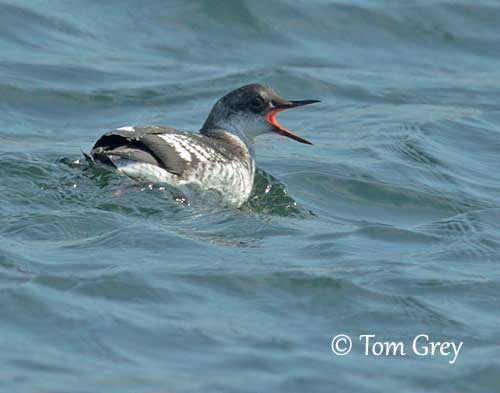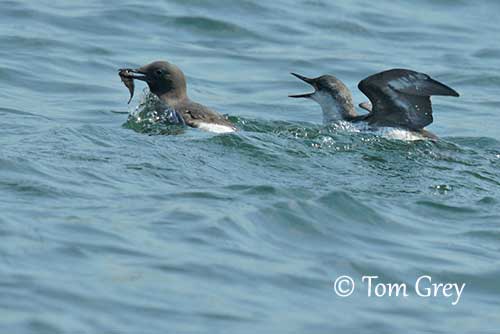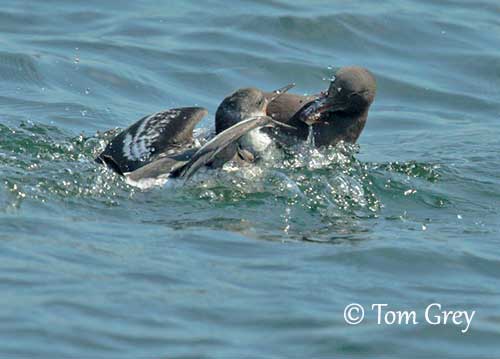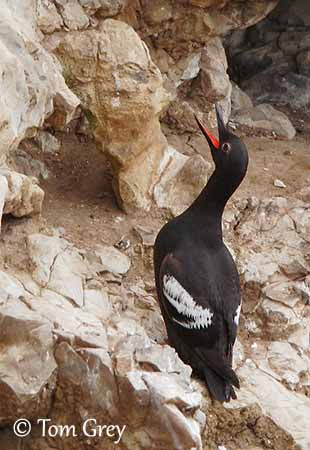
Fr: Guillemot colombin
Ang: Pigeon Guillemot
All: Taubenteiste
Esp: Arao Colombino
Ita: Uria colomba
Nd: Duifzeekoet
Sd: Beringtejst
Photographers:
Tom Grey
Tom Grey's Bird Pictures
Patrick Ingremeau
TAMANDUA
Otto Plantema
Trips around the world
Text by Nicole Bouglouan
Sources:
HANDBOOK OF THE BIRDS OF THE WORLD Vol 3 by Josep del Hoyo-Andrew Elliott-Jordi Sargatal - Lynx Edicions - ISBN : 8487334202
All About Birds (Cornell Lab of Ornithology)
Bird Web (Seattle Audubon Society)
Alaska Seabird Information Species
Alaska Sealife Center – Window to the sea
Seabirds, Forage Fish and Marine Ecosystems Research
What Bird-The ultimate Bird Guide (Mitchell Waite)
Pigeon Guillemot
Cepphus columba
Charadriiformes Order – Alcidae Family
INTRODUCTION:
The Pigeon Guillemot is a medium-sized Alcidae found in the Pacific Ocean. This black seabird is known for its fishing behaviour when it “flies” under water with half-folded wings. It forages close to the rocky coasts in fairly shallow waters.
The Pigeon Guillemot is threatened by oil pollution and predation by mammals and birds, and even at sea by killer whales and octopus. It can be locally killed by inshore gillnet fisheries.
This species also performs beautiful courtship displays such as duet flights and “water games”, accompanied by large repertoire of sounds. It can be found along rocky coastlines from California to Alaska, and along the E coast of Siberia.

DESCRIPTION OF THE BIRD:
Biometrics:
Length: 30-37 cm
Weight: 450-550 g
The adult has blackish-brown plumage overall. On the upperwing, a large white patch is crossed by black bar. The underwing is dusky grey.
The long, strait, pointed bill is black with vermillion mouth-lining. The eyes are dark brown. Legs and webbed feet are bright red with black claws.
Both adults are similar. During winter, they have greyish upperparts with white barring, while head and underparts are white.
The juvenile resembles non-breeding adult with indistinct or obscured white wing patch. Legs and feet are mostly grey-orange.
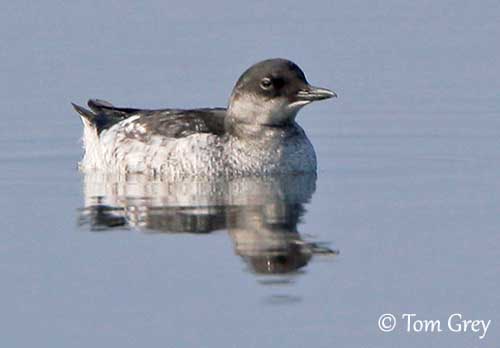
C.c. eureka
Juvenile
SUBSPECIES AND RANGE:
The Pigeon Guillemot has five recognized subspecies.
C.c. snowi is found on Kuril Islands (Paramushir to Iturup). This race has reduced or absent white wing patch.
C.c. Columba is found in Kamchatka, N to Bering Strait and W Alaska.
C.c. kaiurka occurs on Commander Islands to WC Aleutian Islands.
C.c. adiantus occurs on C Aleutian Islands S to Washington.
C.c. eureka is found in Oregon and California.
Among the different races, culmen and wing lengths are decreasing from S to N, except in Bering Sea and Siberia. However, the white in outer primary and underwing-coverts is increasing.
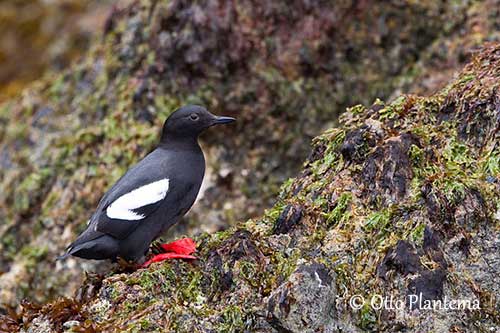
HABITAT:
The Pigeon Guillemot nests along rocky coastlines, both on remote offshore islands and onshore sites. It uses natural cavities, rock crevices in boulders, on cliff faces or among tree roots. According to the availability of nesting cavities, some birds may dig a burrow if they do not find any suitable hollow.
The Pigeon Guillemot forages near the shores, usually in shallow waters of less than 50 metres deep.
During winter, it occurs along rocky sea coasts in sheltered sites. It may forages in opening in ice in Bering Sea and S Alaska.
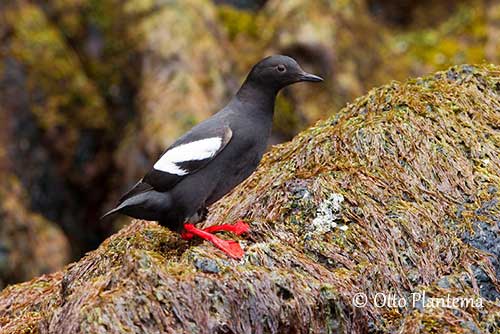
CALLS AND SONGS: SOUNDS BY XENO-CANTO
The Pigeon Guillemot has wider repertoire of sounds than other Alcidae. It utters soft, musical whistles while sitting at the entrance of the nesting cavity, early in the breeding season. The alarm call is a sharp, single note.
Both mates communicate through trilling calls, and several unmelodious calls varying in intensity and frequency according to the situation.
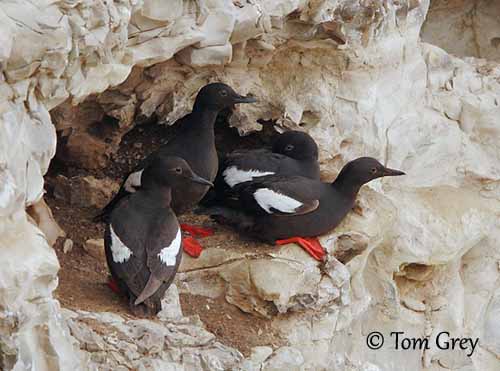
BEHAVIOUR IN THE WILD:
The Pigeon Guillemot feeds mainly on fish and various marine invertebrates including shrimps, crabs, gastropods and bivalve molluscs. These food items are taken all year round. However, the diet varies according to the season and the location.
It forages close to the nesting colony in relatively shallow waters. As they feed close to the seashores, they are vulnerable to oil spills.
It dives for preys, and moves by using its short wings to propel itself under water. It usually follows a zigzag course while searching for preys. It may forage up to 10-30 metres deep.
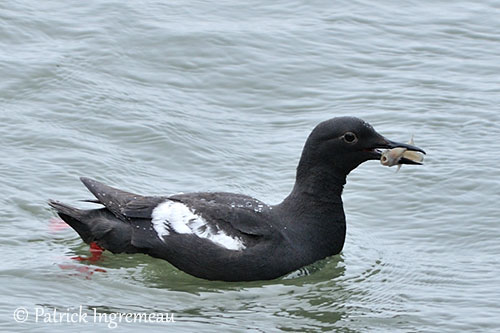
During the breeding season, the Pigeon Guillemot performs beautiful displays accompanied by wide repertoire of sounds. The birds are territorial and some fights may occur sometimes. The opponent can be speared or grabbed with the bill, followed by twisting and turning and strong wingbeats. It may also slash with its sharp claws.
These displays are used as advertising or intimidation behaviour. If they fail, physical contact may occur and last several minutes.
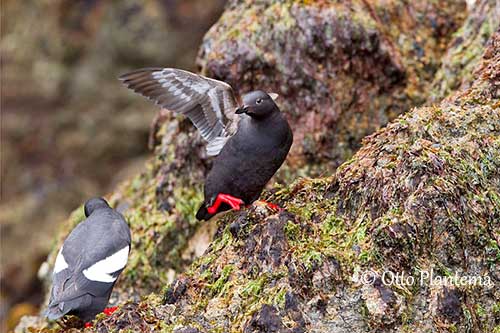
The courtship displays are used to maintain the pair-bond. Both mates fly together and perform “water games” to initiate the courtship behaviour. They perform spectacular chases at water surface or just below, and “leap-frog” competitions. At the colony, whistles and trills are typical during this period. They are monogamous.
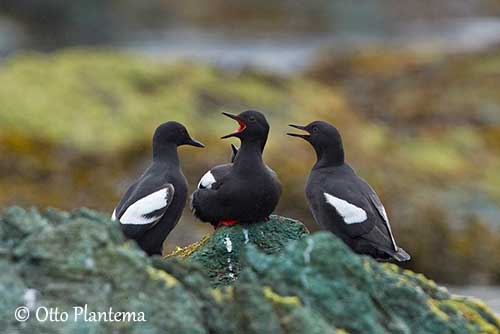
The Pigeon Guillemot’s migrations are poorly known. It usually winters at sea in the Bering Sea, along the coast from Pribilof and Aleutian Islands, S to N Japan (Hokkaido) and S California. However, the population from British Columbia, Washington, Oregon and Kuril Islands often remain near the breeding grounds during winter. California’s birds move N whereas Alaska’s birds move S.
The major migration period takes place in October and March.
Alcidae have a wing size capable of allowing the birds to fly both in the air and in the water. The Pigeon Guillemot has swift, strong, direct flight.
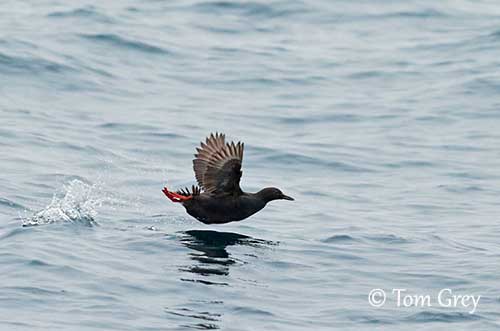
REPRODUCTION OF THIS SPECIES:
The breeding season varies according to the range, with peak-laying between mid-May and mid-June in California and British Columbia, and 1-2 weeks later in Alaska.
The Pigeon Guillemot may nest as single pairs, but usually in colonies of less than 50 birds. It nests in natural cavities such as rock crevices and hollows on cliffs, slopes or boulders. It may sometimes dig a burrow when cavities are not available.
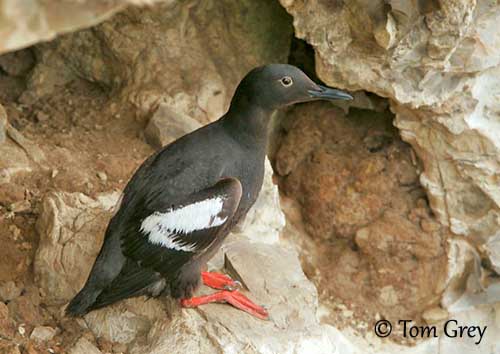
C.c. eureka
Near the nesting cavity
The female lays two eggs. The incubation lasts 28 days for each egg. The chicks are fed by both parents in shifts of 2-4 hours. They have blackish-brown down. They fledge about 35-38 days after hatching, and leave the nest at night. They are completely independent.
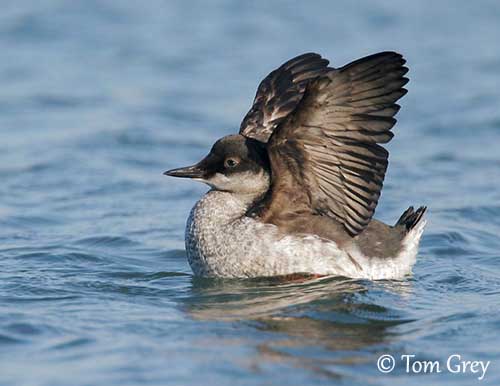
PROTECTION / THREATS / STATUS:
The Pigeon Guillemot is locally vulnerable to oil pollution, inshore gill-net fisheries and introduced mammals on breeding grounds. These problems can cause significant local mortality.
They are affected by heavy predation on eggs and chicks by foxes, river otters and minks. Avian predators such as several Corvidae, also take eggs and chicks, whereas the Bald Eagle preys on adults on the water.
However, the population appears to be stable with even a small increase in N America (2007). The global population is estimated at more than 470,000 individuals.
The Pigeon Guillemot is currently evaluated as Least Concern.
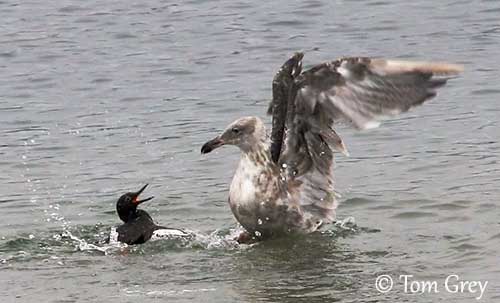
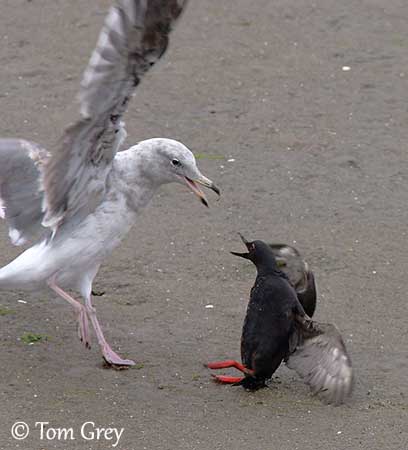
This Pigeon Guillemot is unable to fly but it can swim. Here, it is attacked by a gull, but it will fight in spite of its injuries.
Western Gull immature and Pigeon Guillemot
